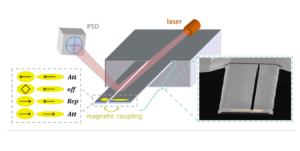People | Publications | Back

One of the most challenging applications of magnetic materials is for memories in electronic industry. The contemporary memories have to be fast, reliable, non-volatile and energy efficient to prevent the prediction of exponential growth of global energy needs for future IC systems based on increased data storage and memory speed. Novel magnetic memories seem to be the effective solution of the energy problems. The solution requires exclusion of mechanical movement parts and external fields. Novel memories based on magnetic materials, MRAM’s, fulfill the requirements and are entering the market just now.
However, the available technology can be improved by exploring various novel concepts in magnetism, studied theoretically and experimentally also by our group. Magnetic nanostructures are considered as novel information storage devices that should serve beyond the limits of the semiconductor technology. The information could be encoded by magnetic texture and controlled by external fields or current. Possible magnetic states are defined by material properties or by device geometry. Observation of magnetic skyrmions stimulated recently intensive research motivated by the potential use as a basic unit of information. The non-collinear magnetism in systems with Dzyaloshinskii-Moriya interaction opens another dimension in nanomagnetic research.
Theory and numerical analysis covers both static and dynamic properties of magnetic structures. Static simulations are focused on finding the stable magnetic state which can be realized in particular nanomagnet. Important parameter for practical use is the height of the energy barrier, which separates the states. It is the key parameter for the stability and reliability of stored information. As an example, we have studied the bi-stable system with two skyrmion states. Such device can encode one bit of information by choosing first or second state of the skyrmion.
The dynamical properties study includes spin waves spectrum, spin waves propagation and magnetic solitons dynamics.
Together with theory is challenging also for experimental preparation of samples, as well as for the magnetic-field imaging systems at nanoscale. Recently, our group has developed three novel methodologies of magnetic force microscopy (MFM). They read:
- Switching magnetization magnetic force microscopy (SM-MFM), based on two-pass scanning with reversed tip magnetization between the scans, spatial resolution achieved is < 10 nm,
- Dual-tip MFM in which is the sample not touched by the magnetic tip – topological and magnetic scans are segregated using two different tips, one magnetic and one non-magnetic,
- Dual-cantilever magnetometer, in which the coupling magnetic forces between the two cantilevers can be switched on/off by an external magnetic field.

Fig. 1. Schematic representation of the dual-cantilever. Possible magnetic states of ellipses (single domain, vortex) are shown in the inset. Mutual forces between cantilevers are attractive (Att), repulsive (Rep) or switched off (off). SEM picture is on the right side.
Recent publications:
Bublikov, K., Tóbik, J., Sadovnikov, A.V., and Mruczkiewicz, M.: Vortex gyrotropic mode in curved nanodots, J. Magnetism Magnetic Mater. 537 (2021) 168105. (ERDF 313021T081 – CEMEA, APVV 16-0068, 19-0311(RSWFA), Era.Net RUS Plus (TSMFA), VEGA 2/0150/18)
Szulc, K., Mendisch, S., Mruczkiewicz, M., Casoli, F., Becherer, M., and Gubbiotti, G.: Nonreciprocal spin-wave dynamics in Pt/Co/W/Co/Pt multilayers, Phys. Rev. B 103 (2021) 134404. ( APVV 16-0068-NanoSky, APVV-19-0311-RSWFA, ERDF 313021T081)
Grachev, A.A., Matveev, O.V., Mruczkiewicz, M., Morozova, M.A., Beginin, E. N., Sheshukova, S.E., and Sadovnikov, A.V.: Strain-mediated tunability of spin-wave spectra in the adjacent magnonic crystal stripes with piezoelectric layer, Applied Phys. Lett. 118 (2021) 262405. (ITMS 313021T081)
Mruczkiewicz, M. and Gruszecki, P.: The 2021 roadmap for noncollinear magnonics, Solid State Phys. 72 (2021) 1-27.
Vetrova, Iu.V., Zelent, M., Šoltýs, J., Gubanov, V.A., Sadovnikov, A.V., Ščepka, T., Dérer, J., Stoklas, R., Cambel, V., and Mruczkiewicz, M.: Investigation of self-nucleated skyrmion states in the ferromagnetic/nonmagnetic multilayer dot, Applied Phys. Lett. 118 (2021) 212409. (ITMS 313021T081, APVV-16-0068, 19-0311(RSWFA), VEGA 2/0160/19)
Zelent, M., Vetrova, Iu.V., Li, X., Zhou, Y., Šoltýs, J., Gubanov, V.A., Sadovnikov, A.V., Ščepka, T., Dérer, J., Stoklas, R., Cambel, V., and Mruczkiewicz, M.: Skyrmion formation in nanodisks using magnetic force microscopy tip, Nanomater. 11 (2021) 2627. (ERDF 313021T081, APVV 19-0311(RSWFA)), ERA.Net RUS Plus (TSMFA), VEGA 2/0160/19)
Feilhauer, J., Schumer, A., Doppler, J., Mailybaev, A.A., Böhm, J., Kuhl, U., Moiseyev, N., and Rotter, S.: Encircling exceptional points as a non-Hermitian extension of rapid adiabatic passage, Phys. Rev. A 102 (2020) 040201. (VEGA 2/0162/18)
Feilhauer, J., Saha, S., Tóbik, J., Zelent, M., Heyderman, L.J., and Mruczkiewicz, M.: Controlled motion of skyrmions in a magnetic antidot lattice, Phys. Rev. B 102 (2020) 184425. (ERDF ITMS 313021T081, APVV-16-0068, 19-0311, Era.Net RUS Plus (TSMFA), VEGA 2/0162/18, 2/0150/18, UF, NSC, Poland UMO-2017/27/N/ST3/00419, No. UMO2018/30/Q/ST3/00416 and Nat. Scholarship Programme SR)
Šoltýs, J., Feilhauer, J., Vetrova, J., Tóbik, J., Bublikov, K., Ščepka, T., Fedor, J., Dérer, J., and Cambel, V.: Magnetic-field imaging using vortex-core MFM tip, Applied Phys. Lett. 116 (2020) 242406. (APVV-16-0068, VEGA 2/0160/19, ERDF 313021T081)
Neilinger, P., Ščepka, T., Mruczkiewicz, M., Dérer, J., Manca, D., Dobročka, E., Samardak, A.S., Grajcar, M., and Cambel, V.: Ferromagnetic resonance study of sputtered Pt/Co/Pt multilayers, Applied Surface Sci 461 (2018) 202-205.
Tóbik, J., Martoňák, R., Cambel, V., : Free-energy landscapes in magnetic systems from metadynamics. Phys. Rev. B 96 (2017)
Mruczkiewicz, M., Krawczyk, M., Guslienko, K., : Spin excitation spectrum in a magnetic nanodot with continuous transitions between the vortex, Bloch-type skyrmion, and Néel-type skyrmion states,. Phys. Rev. B 95 (2017) 094414.
Mruczkiewicz, M., Graczyk, P., Lupo, P., Adeyeye, A., Gubbiotti, G., and Krawczyk, M. : Spin-wave nonreciprocity and magnonic band structure in a thin permalloy film induced by dynamical coupling with an array of Ni stripes, Phys. Rev. B 96 (2017) 104411.
Zeissler, K., Mruczkiewicz, M., Finizio, S., Raabe, J., Shepley, P., Sadovnikov, A.V, Nikitov, S.A., Fallon, K., McFadzean, S., McVitie, S., Moore, T., Burnell, G., and Marrows, C.: Pinning and hysteresis in the field dependent diameter evolution of skyrmions in Pt/Co/Ir superlattice stacks, Sci Rep. 7 (2017) 15125.
Cambel, V., Precner, M., Fedor, J., Šoltýs, J., Tóbik, J., Ščepka, T., Karapetrov, G., : High resolution switching magnetization magnetic force microscopy. Applied Phys. Lett. 102 (2013) 062405.
 Contact
Contact Intranet
Intranet SK
SK

